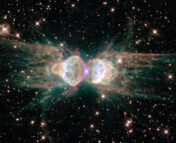Title: Circumbinary disk evolution in the presence of an outer companion star
Authors: Rebecca G. Martin, Stephen Lepp, Stephen H. Lubow, Matthew A. Kenworthy, Grant M. Kennedy, David Vallet
First Author’s Institution: Department of Physics and Astronomy, University of Nevada
Paper Status: Accepted in ApJL [open access on ApJL]
We talk about planets, stars, black holes, and other objects in this mysterious place that we call space quite a lot. However, when planets and stars form, they don’t form in solitude how we are used to imagine – they form in accretion disks. These disks are interesting to study because they have so much physics in them. For example, these disks can be broken, or as scientists call it “misaligned,” which means that some part of a disk can be inclined in a different direction than the other. If this was a CD disk, you wouldn’t be able to listen to any music with it, but the misaligned accretion disks can still successfully form planets and stars!
The authors of today’s paper study the disks that are hosted by stellar binaries, circumbinary disks. There are two competing phenomena that are affecting the disk: polar alignment of the circumbinary disk (an increase of the inclination of the disk) and Kozai-Lidov oscillations of the circumbinary disk (reduction in misalignment). It turns out, the final configuration of the circumbinary disk depends on which of these effects happens faster (the timescale)!
Kozai-Lidov (KL) oscillations are oscillations of the eccentricity and inclination of an orbit in a binary stellar system. This is a dynamic effect that can occur when said binary happens to have a third body as a neighbor. However, the same mechanism can be considered with a circumbinary disk! In this case, when we have a binary of two stars and a disk around it, we consider the initial binary to be a disk+star #1 system and the third object (the neighbor) is star #2.
The authors conducted two sets of simulations: dynamical and hydrodynamical. The first set looked at the gravitational interactions between the bodies, and the second set looked at the gas as well. In the dynamical set of simulations, the authors considered two cases: with (star #1+star #2+star #3) and without a third body (star #1+star #2). They also tried two different semi-major axes. If you take a look at Figure 1, you will see three curves that show analytical estimates for the misalignment (blue and red) and KL oscillations (black). The markers show the results from the dynamical simulations. Squares and triangles show numerical estimates without the third object, and “x” and “+” symbols show numerical estimates with the third object. An analytical estimate of the nodal precession period describes the system well even if it is a hierarchical triple (three stars).
Then, the authors conducted a set of hydrodynamical simulations. The set of hydrodynamical simulations included: 1) a large semi-major axis and high inclination; 2) a large semi-major axis and lower inclination; 3) a small semi-major axis and high inclination. In case #1, the disk undergoes tilt oscillations and aligns towards a polar inclination. Since the tilt oscillations occur over longer timescales, the disk behaves rigidly with little warping. There is also little disk eccentricity growth in this simulation since the inner binary torque is dominating the outer companion torque and suppressing the KL oscillations. At lower inclination (case #2), the KL effect dominates the growth of eccentricity and part of the disk mass is transferred to the third star. In case #3, there is no significant warping of the disk and it undergoes polar alignment, but the outer part of the disk undergoes significant eccentricity growth because of KL oscillations, and therefore part of the disk mass gets transferred to the third star. You can see this mass transfer in Figure 2. There, the disk at some time got perpendicular to the binary’s orbit!
So, the sets of dynamical and hydrodynamical simulations showed that if the polar alignment timescale is shorter than the KL timescale, the disc undergoes polar alignment. If it is longer, then it becomes highly eccentric and it gets destroyed, either by accretion onto the inner binary or by forming a disk around the third star. If both timescales are somewhat similar, the disk undergoes polar alignment and the outer part of the disk becomes eccentric. Also, the range of inclinations that allows for polar alignment is reduced by the presence of the third body.
Here, we could see that the motions in space are even messier and more chaotic than we thought they were, because the accretion disks are also involved in the game, and they hide secrets too!
Astrobite edited by Catherine Manea
Featured image credit: NASA/JPL-Caltech/T. Pyle (SSC), IMDb



